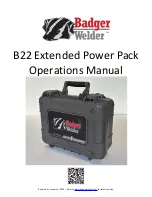
2. INTRODUCTION
D
urable composite housing and soft grip for added comfort. Variable speed trigger for easy control. Forward and reverse rotation and
trigger-lock. Fitted with electronic brake. Built-in LED work light for low visibility areas. Requires compatible 20V battery and mains charger,
sold separately.
3. SPECIFICATION
Model No: .............................................................
CP20VRW
B
attery:
O
ptions: 20V 2Ah Li-ion, 20V 4Ah Li-ion,
20V 6Ah Li-ion (not included)
Drive: ..........................................................................
3/8”Sq
M
aximum torque:
..........................................................
60Nm
N
o-Load speed
.......................................................
0-250rpm
Noise power: ........................................................
100.2dB(A)
Noise pressure .......................................................
89.2dB(A)
V
ibration: ................................................................
7.972m/s²
Uncertainty: ................................................................
1.5m/s²
Replacement parts .........................
CP20VMC mains charger
4. OPERATION
Unpack the product and check contents. Should there be any damaged or missing parts contact your supplier immediately.
4.1.
BATTERY INSTALLATION
4.1.1.
To insert the battery align the tongues on the battery cartridge with the grooves on the handle of the wrench, and slide into place.
Insert the battery all the way until it locks into place.
4.2.
BATTERY REMOVAL
4.2.1.
Hold the wrench firmly and push the battery latch button, then slide and remove the battery.
4.3.
STARTING THE WRENCH
4.3.1.
Prior to starting the wrench ensure that the trigger lock is in the unlocked position (fully towards battery cartridge).
4.3.2.
Apply pressure on the trigger to start the wrench. The tool speed is controlled by varying the pressure on the trigger. Release the
trigger to stop.
NOTE:
When not in use put the trigger lock into the locked position (fully towards the drive socket).
4.4.
WORK LIGHT
4.4.1.
The work light will switch on when the trigger is lightly pressed, and will go out automatically after approximately 10 seconds after
the trigger is released.
NOTE:
When the wrench is overheated the work light will begin to blink. Allow the wrench to fully cool before operating the
wrench again.
4.5.
USING THE WRENCH
4.5.1.
Fit the correct size socket required to the wrench by pushing it onto the square socket adaptor until it locks into place. To remove
the socket, simply pull it off.
NOTE:
Always use the correct size socket for the bolt or nut. An incorrect size socket could result in inconsistent fastening torque
and/or damage to the socket, fixing or wrench.
4.5.2.
Select the required direction of rotation. To change rotational direction turn the reversing lever clockwise or counter-clockwise
until an audible click is heard.
9
Always check the direction of rotation prior to use.
DO NOT
attempt to change the direction of rotation whilst the trigger is depressed. Change direction only when the wrench comes
to a complete stop.
4.5.3.
Hold the wrench firmly and place the socket over the bolt or nut. Turn the wrench on and fasten. When the bolt or nut reaches the
seating position, the wrench will stop automatically.
4.5.4.
When tightening take care not to over-torque small fixings.
WARNING!
Hold the wrench firmly especially when the fixing reaches the seating position and the socket stops it’s rotation the
motor will generate an instant backlash to rotate the wrench.
NOTE:
On critical fixings always check the torque with a torque wrench according to the product or vehicle manufacturer’s
guidelines.
4.6.
USING AS A HAND TOOL
4.6.1.
The wrench can be used as a hand ratchet wrench tool to assist in the loosening of stiff bolts or nuts, by hand.
4.6.2.
When the bolt or nut has been adequately loosened, unlock the wrench and turn on to complete the task.
WARNING! – Risk of Hand Arm Vibration Injury.
This tool may cause Hand Arm Vibration Syndrome if its use is not managed adequately.
This tool is subject to the vibration testing section of the Machinery Directive 2006/42/EC.
This tool is to be operated in accordance with these instructions.
Measured vibration emission value (a)...........................7.972m/s²
Uncertainty value (k):.........................................................1.5m/s²
Please note that the application of the tool to a sole specialist task may produce a different average vibration emission. We
recommend that a specific evaluation of the vibration emission is conducted prior to commencing with a specialist task.
A health and safety assessment by the user (or employer) will need to be carried out to determine the suitable duration of use for
each tool.
N B: Stated Vibration Emission values are type-test values and are intended to be typical.
Whilst in use, the actual value will vary considerably from and depend on many factors.
Such factors include; the operator, the task and the inserted tool or consumable.
NB: ensure that the length of leader hoses is sufficient to allow unrestricted use, as this also helps to reduce vibration.
C
P20VRW Issue 1 28/09/21
Original Language Version
© Jack Sealey Limited





















